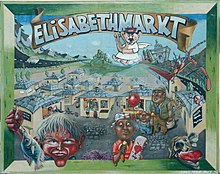Elisabeth Market
The Elisabethmarkt (also: Markt am Elisabethplatz) is one of the four permanent markets for food and flowers in Munich . It takes place on Elisabethplatz in the Schwabing district. After a TÜV report found deficiencies in hygiene and fire protection on stands in 2011 , the city of Munich is planning to rebuild the market. At the beginning of 2020, the district committee approved the conversion plans including the construction of an underground car park under the market area.
history
Elisabethplatz and Elisabethstraße were named in 1898 after the Empress Elisabeth of Austria , better known as Sisi. She was the daughter of Duke Max Joseph in Bavaria and cousin of King Ludwig II. In 1854 she married Emperor Franz Joseph I , after whom Franz-Joseph-Strasse was named in 1894. The couple often stayed with their relatives in Schwabing.
The market at Elisabethplatz was founded in 1903. Its roots go back much further, however, because the Elisabethmarkt is the former market on Maffeianger, founded in 1880, which, however, had to be relocated from Maffeianger to Elisabethplatz due to planned road construction work. On October 1, 1903, the market on Elisabethplatz was brought into being by a resolution of the municipal authorities .
In mobilization for World War I , the market had its own Inskriptions office, in the war loans were drawn. The market itself consisted of a few permanent places as well as daily sales places, which the magistrate auctioned off every 5 years or raffled off by the market inspector. The market hall on Elisabethplatz, which was built in 1903, fell victim to bombs in World War II , which also severely damaged the market as a whole. The business was maintained as far as possible by the dealers and the city administration . After the Second World War, the market was rebuilt and the market hall was replaced by sales houses, which still shape the image of the Elisabethmarkt today.
administration
The Elisabethmarkt is managed by Markthallen München , which is owned by the City of Munich. The use of the market for traders, buyers and passers-by is regulated by the food market statute. These statutes also apply to the Viktualienmarkt , the Pasinger Viktualienmarkt and the Wiener Markt .
The dealers in the market do not have a lease, but a so-called assignment ( administrative act ). On the one hand, this has historical reasons, as the market was and is part of the city administration. On the other hand, it is stipulated in the food market statute. The fees consist of a basic fee and a sales fee and are based on the fee statute for the grocery stores. It is not possible to make a general statement about the fees for a stand, as many factors (stand, cellar, range) result in a separate fee for each stand. Requests for a stand on the market are placed on a reserve list. If a stand becomes available, the relevant reserved will be written to. In principle, a stand that becomes vacant is filled with the same product range in order to maintain market equilibrium. The stands are assigned according to various criteria: concept, experience, economic background, etc.
Around the market
In the south there is a small substation of the Stadtwerke München . The western market area is bounded by Arcisstrasse, on the opposite side of which are the state-run Gisela-Gymnasium and the vocational training center (in the Elisabethplatz 4 building built in 1901 by Theodor Fischer as a primary school). In the northern area are the green areas of Elisabethplatz and the Wintergarten restaurant. Residential and commercial buildings and the Schauburg (Munich) , the theater of young people, stretch along Nordendstrasse to the east .
graffiti
At the beginning of the 1990s, larger-than-life graffiti on the subject of energy was affixed to the Stadtwerke München building to the south of the market . The dealers liked this so much that they wanted graffiti like this to make the market stand out. In 1996, students from the University of Applied Sciences in Munich designed a graffiti on the Elisabethmarkt on the side facing the market, which still catches the viewer's eye today.
Others
The pavilion on Nordendstrasse , the Milchhäusl, dates from the end of the 19th century. The building was suggested by the doctor and abstainer Carl Brendel , who then personally watched over the fact that milk was served here every morning from 5 a.m. His goal was the health of the population, especially the "containment of the toxin alcohol". However, this only with limited long-term success, because today a small restaurant called Wintergarten with beer garden has moved in here.
Individual evidence
- ↑ Ellen Draxel: With charm into the modern age. sueddeutsche.de, July 9, 2015, accessed on July 14, 2015 .
- ↑ Local politicians approve plans for Elisabethmarkt. In: www.sueddeutsche.de. February 4, 2020, accessed March 16, 2020 .
- ↑ http://www.muenchen.de/sehenswuerdheiten/orte/130670.html
- ↑ a b https://www.muenchen.de/rathaus/dam/jcr:f4d20cc3-686d-4657-8c7a-267abc4c9b23/gebuehrsatzung_mhm.pdf
Web links
Coordinates: 48 ° 9 ′ 24.6 " N , 11 ° 34 ′ 27.8" E





